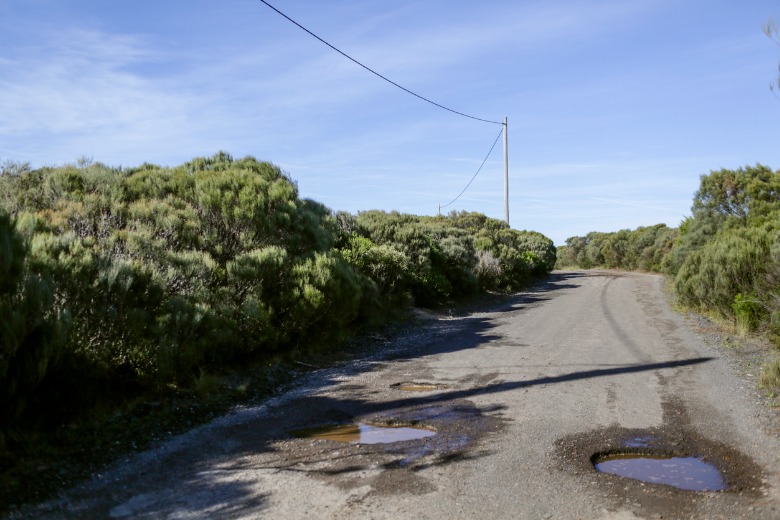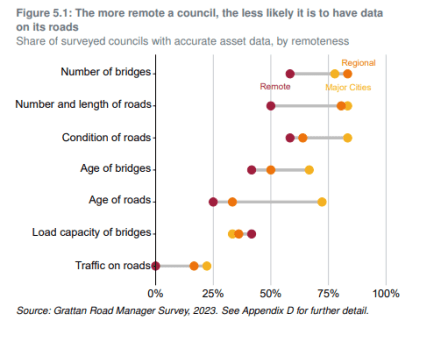
More than 75 per cent of Australia’s roads are managed by councils, but an ‘extraordinary number’ of them don’t even know which roads they are responsible for, a Grattan Institute survey has found.

The Grattan Institute surveyed council road managers from 81 councils in mid 2023, covering how councils operate, their funding arrangements, their asset-management practices, and the challenges they face in managing their roads.
The survey found one in four councils don’t know exactly which roads and bridges they manage. When it came to remote councils, almost half were in the dark.
Only 15 per cent of councils had accurate data on the traffic flows on their roads, and just over a third knew the load capacity of their bridges.
Very few councils knew the average cost of performing different maintenance and renewal activities, such as re-filling a pothole or resealing a portion of a road, and even fewer knew how much maintenance activities for different road types typically cost on an annual basis.
“Managing extensive assets in a way that meets community expectations while balancing costs and risks is not easy,” the institute says in a report released this week titled Potholes and Pitfalls: How to Fix Local Roads.
“It requires high-quality and timely data, extensive planning in collaboration with the community, and following through with those plans.
“But many councils don’t even know what roads and bridges they manage, or meet legislated requirements for planning and community consultation.”
More federal support
The report says councils need more support from the federal government to help them manage their roads.
That includes the establishment of a national road hierarchy, minimum service standards, and basic data specifications for them to follow, as well as funding and support to acquire the necessary technology and staff capabilities to collect and use the data.
State governments should provide templates to help under-resourced councils create and maintain asset management plans and long-term financial plans in a consistent way, the report recommends.

‘Dangerous state of disrepair’
As foreshadowed by Government News earlier this year, the report highlights a steady erosion of federal roads funding over the last ten years which it says has left many councils, especially those in rural and remote areas, struggling to meet the shortfall.
“A lot of local councils don’t have enough money to look after the roads that they’re responsible for properly,” report author Marion Terrill said in a podcast.
“There’s several reasons for this. Firstly, there’s not enough money because the Commonwealth’s untied grant funding to councils over the past decade has not kept pace with the costs to local councils.
there’s not enough money because the Commonwealth’s untied grant funding to councils over the past decade has not kept pace with the costs to local councils.
Marion Terrill
“But partly also because the way they index it It’s for CPI, not for what the for a more suitable measure of what local councils actually need to spend.”
The report says the situation has left the nation’s local roads in a dangerous state of disrepair and calls for an extra $1 billion of funding each year.
It recommends a $600 million annual increase in Financial Assistance Grants, and a $400 million annual increase to Roads to Recovery funds, both indexed to changes in the costs that councils face, and population.
Red tape and ‘time wasting obligations’
Councils also need to wade through a “morass of red tape and time-wasting obligations” linked to roads funding, the report says.
The report calls for local roads funding for major city councils and densely populated states to be cut and redirected towards rural, regional and under-resourced councils.

“Taxpayers would also get better value if the federal government stopped favouring the densely populated states of NSW and Victoria, to the detriment of Tasmania and the NT, and cut back the share of the funding pool it directs to metropolitan councils that are already self-sufficient,” the report says.
Local government minister and former Eden-Monaro Mayor Kristy McBain said it wasn’t just on the federal government to deal with roads issues, and it was important to work and collaborate across governments.
Other factors were contributing to the parlous state of local roads, she said, including significant weather events, rising contractor costs and supply chain constraints.
The government had provided an additional $250 million to the Local Roads and Community Infrastructure grant fund to address those issues, Ms McBain said.
“We want to continue to work with (councils) on how we get more dollars out there,” she told 2GB.
Comment below to have your say on this story.
If you have a news story or tip-off, get in touch at editorial@governmentnews.com.au.
Sign up to the Government News newsletter
Road Safety Authorities should consider lowering the speed limit on some of these B roads that are in poor and dangerous condition. I recently drove on Burley Griffin Way (B94) and between Binalong and Temora I had to dodge heavy vehicles twice in an hour partly on my side of the road across unbroken double lines which gets one’s attention.
Terry Yass NSW